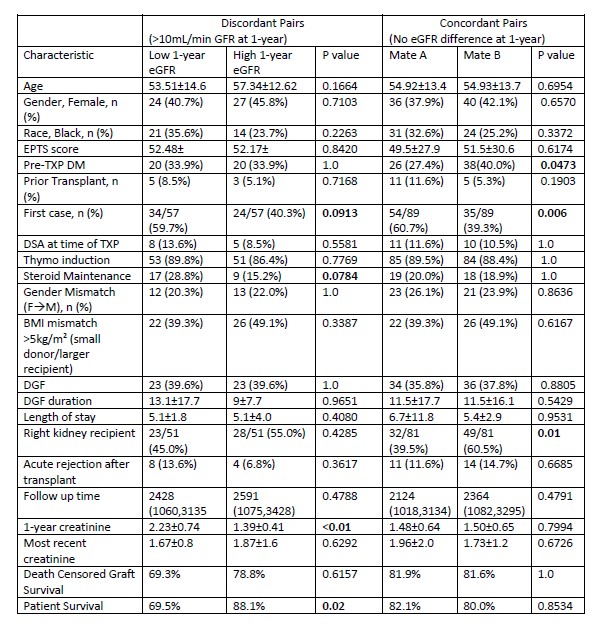Meet Your Mate: Lessons Gleaned from Analysis of 154 Paired Kidneys Transplanted at a Single Center
1Division of Nephrology, New York, NY, 2Surgery, NYP-Weill Cornell, New York, NY
Meeting: 2019 American Transplant Congress
Abstract number: C44
Keywords: Graft failure, Graft function, Kidney transplantation
Session Information
Session Name: Poster Session C: Kidney Complications: Late Graft Failure
Session Type: Poster Session
Date: Monday, June 3, 2019
Session Time: 6:00pm-7:00pm
 Presentation Time: 6:00pm-7:00pm
Presentation Time: 6:00pm-7:00pm
Location: Hall C & D
*Purpose: The factors affecting graft and patient survival are in many studies confounded by center and donor related factors. Mate kidney analyses can help to examine recipient related factors that may lead to adverse graft outcomes where both donor and center-related factors are controlled.
*Methods: We reviewed the charts of all deceased donor transplants at our center since 2002. We found a total of 154 pairs of kidneys where both kidneys were transplanted at our center and had a graft and patient survival of at least 30 days. We calculated the MDRD eGFR of all patients at 1-year. Discordant mates were defined as an eGFR difference of ≥10mL/min at 1-year. Concordant mates were those with <10mL/min eGFR difference at 1 year. Primary outcomes assessed were graft and patient survival
*Results: We found that a large number of paired kidneys, 38.3% (59), had a difference in eGFR at 1 year ≥10mL/min. When looking at the differences between discordant pairs, there was little difference in demographics between the recipients (Table 1). More patients in the low eGFR group had DSA at the time of transplant and were placed on steroid maintenance therapy for immunologic reasons, although this was not significant. There were twice as many episodes of acute rejection in lower GFR group but this was not significant. We also analyzed common etiologies of graft dysfunction including: cold ischemia time, left versus right kidney, gender mismatch (female to male transplant), BMI mismatch, as well as post-transplant events such as length of stay, delayed graft function and found no difference between the groups. 1-year creatinine was higher in the low GFR group (p<0.01) and the low eGFR group showed a trend toward worse graft survival (69.3% vs. 78.8%, p = 0.62). There was significantly worse survival in the low GFR group when compared to the other groups (Figure 1).
*Conclusions: Our large single center analysis of mate kidneys demonstrates that most mate kidneys perform with similar function despite a wide variety of recipient factors. The most important recipient factors appear to be immunologic in nature. Worse graft function at 1 year portends worse graft and patient survival.
To cite this abstract in AMA style:
Lubetzky M, Aull M, Rhee K, Sultan S, Kapur S. Meet Your Mate: Lessons Gleaned from Analysis of 154 Paired Kidneys Transplanted at a Single Center [abstract]. Am J Transplant. 2019; 19 (suppl 3). https://atcmeetingabstracts.com/abstract/meet-your-mate-lessons-gleaned-from-analysis-of-154-paired-kidneys-transplanted-at-a-single-center/. Accessed December 15, 2025.« Back to 2019 American Transplant Congress


